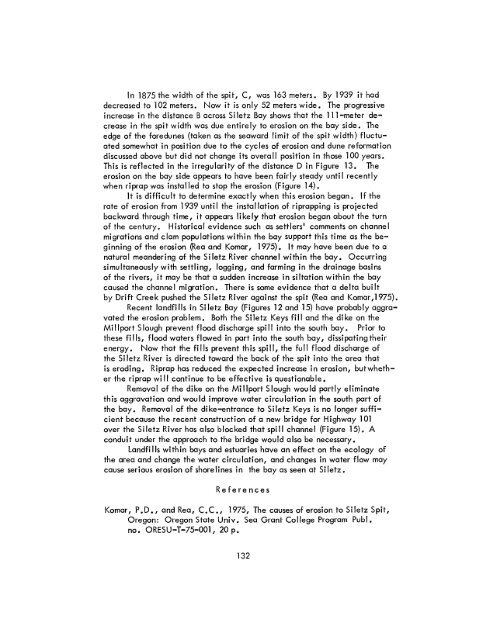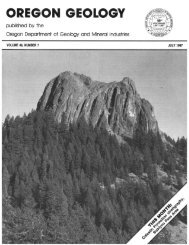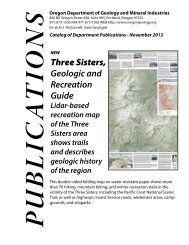The Ore Bin - Oregon Department of Geology and Mineral Industries
The Ore Bin - Oregon Department of Geology and Mineral Industries
The Ore Bin - Oregon Department of Geology and Mineral Industries
You also want an ePaper? Increase the reach of your titles
YUMPU automatically turns print PDFs into web optimized ePapers that Google loves.
In 1875 the width <strong>of</strong> the spit, C, was 163 meters. By 1939 it had<br />
decreased to 102 meters. Now it is only 52 meters wide. <strong>The</strong> progressive<br />
increase in the distance B across Siletz Bay shows that the lll-meter decrease<br />
in the spit width was due entirely to erosion on the bay side. <strong>The</strong><br />
edge <strong>of</strong> the foredunes (taken as the seaward limit <strong>of</strong> the spit width) fluctuated<br />
somewhat in position due to the cycles <strong>of</strong> erosion <strong>and</strong> dune reformation<br />
discussed above but did not change its overall position in those 100 years.<br />
This is reflected in the irregularity <strong>of</strong> the distance D in Figure 13. <strong>The</strong><br />
erosion on the bay side appears to have been fairly steady unti I recently<br />
when riprap was installed to stop the erosion (Figure 14).<br />
It is difficult to determine exactly when this erosion began. If the<br />
rate <strong>of</strong> erosion from 1939 unti I the installation <strong>of</strong> riprapping is projected<br />
backward through time, it appears likely that erosion began about the turn<br />
<strong>of</strong> the century. Historical evidence such as settlers' comments on channel<br />
migrations <strong>and</strong> clam populations within the bay support this time as the beginning<br />
<strong>of</strong> the erosion (Rea <strong>and</strong> Komar, 1975). It may have been due to a<br />
natural me<strong>and</strong>ering <strong>of</strong> the Siletz River channel within the bay. Occurring<br />
simultaneously with settling, logging, <strong>and</strong> farming in the drainage basins<br />
<strong>of</strong> the rivers, it may be that a sudden increase in siltation within the bay<br />
caused the channel migration. <strong>The</strong>re is some evidence that a delta built<br />
by Drift Creek pushed the Siletz River against the spit (Rea <strong>and</strong> Komar,1975).<br />
Recent l<strong>and</strong>fills in Siletz Bay (Figures 12 <strong>and</strong> 15) have probably aggravated<br />
the erosion problem. Both the Siletz Keys fill <strong>and</strong> the dike on the<br />
Mi II port Slough prevent flood discharge spi II into the south bay. Prior to<br />
these fi lis, flood waters flowed in part into the south bay, dissipating their<br />
energy. Now that the fills prevent this spill, the full flood discharge <strong>of</strong><br />
the Siletz River is directed toward the back <strong>of</strong> the spit into the area that<br />
is eroding. Riprap has reduced the expected increase in erosion, butwhether<br />
the riprap will continue to be effective is questionable.<br />
Removal <strong>of</strong> the dike on the Millport Slough would partly eliminate<br />
this aggravation <strong>and</strong> would improve water circulation in the south part <strong>of</strong><br />
the bay. Removal <strong>of</strong> the dike-entrance to Siletz Keys is no longer sufficient<br />
because the recent construction <strong>of</strong> a new bridge for Highway 101<br />
over the Siletz River has also blocked that spill channel (Figure 15). A<br />
conduit under the approach to the bridge would also be necessary.<br />
L<strong>and</strong>fills within bays <strong>and</strong> estuaries have an effect on the ecology <strong>of</strong><br />
the area <strong>and</strong> change the water circulation, <strong>and</strong> changes in water flow may<br />
cause serious erosion <strong>of</strong> shorelines in the bay as seen at Siletz.<br />
References<br />
Komar, P.D., <strong>and</strong> Rea, C.C., 1975, <strong>The</strong> causes <strong>of</strong> erosion to Siletz Spit,<br />
<strong>Ore</strong>gon: <strong>Ore</strong>gon State Univ. Sea Grant College Program Publ.<br />
no. ORESU-T-75-001, 20 p.<br />
132









